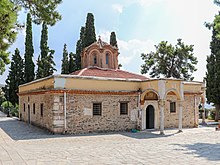Vlatades Monastery
The Vlatades Monastery ( Greek Μονή των Βλατάδων Moní ton Vlatádon ) is the only surviving Byzantine monastery in the city of Thessaloniki . It is a stauropegic , i.e. H. Monastery directly subordinate to the Ecumenical Patriarchate , is located in the upper town immediately below the Acropolis and has been part of the UNESCO World Heritage since 1988 ( early Christian and Byzantine buildings in Thessaloniki ). There are several cisterns of the water pipeline from the Chortiatis on the monastery grounds . The monastery has several churches inside and outside the city.
history
The monastery, which was probably founded in the middle of the 14th century, was first dedicated to the ruler of the world (Pantokrátor), now it is a Transfiguration Monastery. After the city was conquered by the Turks, it was likely to have fallen into Islamic hands for a short time. In the Turkish times it was called Çavuş Manastır .
investment
The main church of the monastery, the Katholikón, is surrounded by new buildings of the Patriarchical Research Institute, which was founded in 1968. It is a variant of the cross- domed church , in which the dome , resting on an eight-sided drum, does not rest on four columns, but on the walls of the altar apse and two pilasters in the west, which is already attributed to the previous building. The core building is surrounded on three sides by a walkway with two chapels in the east, which was largely built in 1801 and 1907. The masonry consists of quarry stone and alternating layers of brick. In 1980/1981 frescoes were discovered in the main room and in the hallway, which are attributed to the time around 1370. The iconostasis dates from the 17th century.
literature
- G. Stogioglou: Η εν Θεσσαλονίκη πατριαρχική Μονή των Βλατάδων. Thessaloníki 1971.
- Ch. Mavropoulou-Tsioumi: Μονή Βλατάδων. Thessaloniki 1987.
- A. Tourta: Σκευφυλάκιο Ιεράς Μονής Βλατάδων. Athens 1994.
Web links
- [1] Website of the monastery
Individual evidence
- ↑ UNESCO World Heritage List - Paleochristian and Byzantine Monuments of Thessalonika (English)
- ↑ K. Kourkoutidou-Nikolaïdou / A. Tourta: Walks through Byzantine Thessaloniki. Athens 1997: Kapon Editions. Pp. 100-104. ISBN 960-7254-48-1
Coordinates: 40 ° 38 ′ 29.8 ″ N , 22 ° 57 ′ 15.6 ″ E

